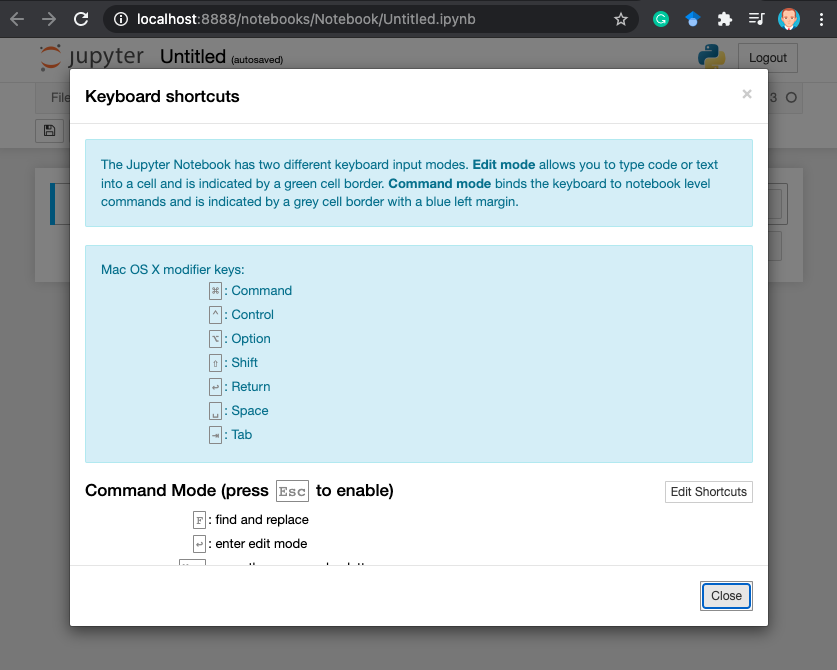Jump to: Command Mode (press Esc to enable), Edit Mode (press Enter to enable)


When the notebook is refreshed in Jupyter, cell inputs are loaded from the script or Markdown document and kernel variables are preserved. Activating a Markdown cell Text can be added to Jupyter Notebooks using Markdown cells. You can change the cell type to Markdown by using the Cell menu, the toolbar, or the key shortcut m. Markdown is a popular markup language that is a superset of HTML.
Jupyter Enable Markdown
Enter | enter edit mode |
Shift+Enter | run cell, select below |
Ctrl+Enter | run cell |
Alt+Enter | run cell, insert below |
Y | to code |
M | to markdown |
R | to raw |
1 | to heading 1 |
2,3,4,5,6 | to heading 2,3,4,5,6 |
Up/K | select cell above |
Down/J | select cell below |
A/B | insert cell above/below |
X | cut selected cell |
C | copy selected cell |
Shift+V | paste cell above |
V | paste cell below |
Z | undo last cell deletion |
D | delete selected cell |
Shift+M | merge cell below |
Ctrl+S | Save and Checkpoint |
L | toggle line numbers |
O | toggle output |
Shift+O | toggle output scrolling |
Esc | close pager |
H | show keyboard shortcut help dialog |
I | interrupt kernel |
0 | restart kernel |
Space | scroll down |
Shift+Space | scroll up |
Shift | ignore |
Jupyter New Cell Shortcut
Tab | code completion or indent |
Shift+Tab | tooltip |
Ctrl+] | indent |
Ctrl+[ | dedent |
Ctrl+A | select all |
Ctrl+Z | undo |
Ctrl+Shift+Z | redo |
Ctrl+Y | redo |
Ctrl+Home | go to cell start |
Ctrl+Up | go to cell start |
Ctrl+End | go to cell end |
Ctrl+Down | go to cell end |
Ctrl+Left | go one word left |
Ctrl+Right | go one word right |
Ctrl+Backspace | delete word before |
Ctrl+Delete | delete word after |
Esc | command mode |
Ctrl+M | command mode |
Ctrl+Shift+minus | split cell |
Ctrl+S | Save and Checkpoint |
Up | move cursor up or previous cell |
Down | move cursor down or next cell |
Ctrl+/ | toggle comment on current or selected lines |
Convert Jupyter Notebook To Markdown
Created by SarthakMenpara on 6/19/2017
Bold In Jupyter Markdown
0 Comments for 'Jupyter Notebook '
